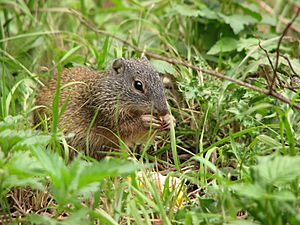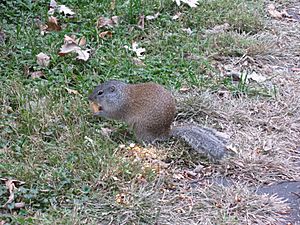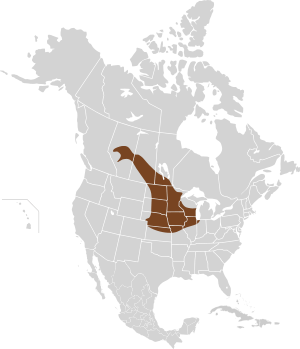Franklin's ground squirrel facts for kids
Quick facts for kids Franklin's ground squirrel |
|
|---|---|
 |
|
| In Alberta, Canada | |
| Conservation status | |
| Scientific classification | |
| Genus: |
Poliocitellus
|
| Species: |
franklinii
|
| Synonyms | |
|
Spermophilus franklinii |
|
The Franklin's ground squirrel (Poliocitellus franklinii) is a type of squirrel that lives in North America. It is the only species in its special group, called Poliocitellus. Sadly, there are fewer of these squirrels now. This is because their natural home, the prairie, is being destroyed. In the eastern parts of where they live, their homes are often broken up into smaller pieces, which makes it hard for them to survive.
Contents
About the Franklin's Ground Squirrel
Naming and Classification
The Franklin's ground squirrel was first described in 1822 by a scientist named Joseph Sabine. He named it to honor Sir John Franklin, a British explorer who explored the Arctic.
For a long time, this squirrel was part of a larger group of ground squirrels called Spermophilus. But scientists used a method called DNA sequencing (looking at the animal's genetic code) to study its family tree. They found that the Franklin's ground squirrel was unique enough to have its own group, or genus. That's why it's now in the genus Poliocitellus.
What Does It Look Like?
Franklin's ground squirrels are medium-sized. Adults are usually about 36 to 41 centimeters (14 to 16 inches) long, including their tail. Their tail is about 11 to 15 cm (4 to 6 inches) long.
Male squirrels are heavier than females. In spring, males weigh about 370 grams (13 ounces). By fall, they can weigh up to 950 grams (2 pounds), getting ready for winter. Females are lighter, weighing about 320 grams (11 ounces) in spring and up to 760 grams (1.7 pounds) in fall.
Their fur is brownish-grey with light and dark speckles. Their belly is a yellowish-white color. The tail is darker, almost black, and their head is a solid grey.
How to Tell Them Apart from Other Squirrels
Franklin's ground squirrels look a lot like the common eastern grey squirrel. However, the Franklin's squirrel has a shorter, less bushy tail. It also has shorter ears, longer claws, and a patch of yellowish fur on its rump (lower back), which the eastern grey squirrel doesn't have.
Other squirrels you might confuse it with are Richardson's ground squirrel (which is stockier and has a longer tail) and the Columbian ground squirrel (which has reddish fur).
Special Scent Glands
These squirrels have several scent glands. They have small glands near their mouth, which they might use when they meet other squirrels. They also have glands running from their shoulders to their hips, which they might use to mark their burrows.
The largest glands are three anal glands, located near their bottom. These glands produce a musky smell during the mating season. Both male and female squirrels have these glands.
Where Do They Live?
Franklin's ground squirrels live in parts of Canada and the United States. In Canada, they are found from central Alberta to southern Manitoba. In the United States, they live from North Dakota and Minnesota down to northern Kansas and northwestern Indiana.
They prefer to live in tallgrass prairies where there is a lot of thick plant cover. You can often find them near the edges of woodlands or marshy areas.
Life Cycle and Habits
What Do They Eat?
Franklin's ground squirrels eat both plants and animals, which means they are omnivores. In spring and late summer, they mostly eat plants. But in early summer, meat and eggs become a big part of their diet.
- Spring: They eat roots, new shoots, and grasses.
- Later in the year: They switch to leaves, flowers, fruits, and seeds.
- Favorite plants: They enjoy dandelions, stinging nettles, red-berried elders, white clover, and wild peas. They also eat garden vegetables.
- Animal food: They eat insects, eggs, small rodents, fish, and frogs. Sometimes, they even eat larger animals like rabbits or even full-grown mallard ducks!
Hibernation and Predators
These squirrels hibernate (sleep through winter) from about August to April. The exact timing can change for each squirrel. Males usually start hibernating earlier than females. Adults go into hibernation before the young squirrels born that year, because the young ones need more time to build up fat.
Badgers are the main animals that hunt Franklin's ground squirrels. Other predators include coyotes, foxes, weasels, hawks, and snakes.
Reproduction
The mating season for Franklin's ground squirrels starts as soon as they wake up from hibernation in the spring. It continues until June. During this time, a male and female squirrel might share a burrow.
- Gestation: Pregnancy lasts for 28 days.
- Litter size: A mother can have anywhere from two to thirteen babies (called pups), but usually, they have about eight.
- Newborns: Pups are born naked and blind. Their eyes open after 18 to 20 days.
- Weaning: They stop drinking their mother's milk by 30 days old.
- Maturity: Females can have babies when they are two years old. They can live for four to five years. Males usually don't live past two years old.
Daily Behavior
Franklin's ground squirrels are diurnal, meaning they are active during the day. They spend the night sleeping in their burrows. They usually build their burrows on steep slopes.
- Burrow size: Burrows are about 8 cm (3 inches) wide and go about 43 cm (17 inches) deep into the ground.
- Burrow structure: Each burrow has one main nesting room, which is lined with dried plants. There are also several side tunnels that lead to places where they store food and to special areas they use as bathrooms.
- Entrances: Burrows usually have two or three entrances.
During spring and summer, these squirrels are generally not very social. One or two squirrels usually live in each burrow. In North Dakota, males have a larger home area (about 24 hectares or 59 acres) than females (about 9 hectares or 22 acres). However, the home areas of different squirrels can overlap. In winter, several squirrels might share the same burrow to stay warm.




